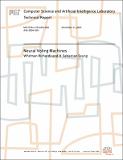Neural Voting Machines
| dc.contributor.author | Richards, Whitman | |
| dc.contributor.author | Seung, H. Sebastian | |
| dc.date.accessioned | 2005-12-22T02:20:05Z | |
| dc.date.available | 2005-12-22T02:20:05Z | |
| dc.date.issued | 2004-12-31 | |
| dc.identifier.other | MIT-CSAIL-TR-2004-083 | |
| dc.identifier.other | AIM-2004-029 | |
| dc.identifier.uri | http://hdl.handle.net/1721.1/30513 | |
| dc.description.abstract | “Winner-take-all” networks typically pick as winners that alternative with the largest excitatory input. This choice is far from optimal when there is uncertainty in the strength of the inputs, and when information is available about how alternatives may be related. In the Social Choice community, many other procedures will yield more robust winners. The Borda Count and the pair-wise Condorcet tally are among the most favored. Their implementations are simple modifications of classical recurrent networks. | |
| dc.format.extent | 12 p. | |
| dc.format.extent | 13714512 bytes | |
| dc.format.extent | 523751 bytes | |
| dc.format.mimetype | application/postscript | |
| dc.format.mimetype | application/pdf | |
| dc.language.iso | en_US | |
| dc.relation.ispartofseries | Massachusetts Institute of Technology Computer Science and Artificial Intelligence Laboratory | |
| dc.subject | AI | |
| dc.subject | WTA | |
| dc.subject | Borda machine | |
| dc.subject | Condorcet procedure | |
| dc.subject | neural network | |
| dc.title | Neural Voting Machines |
